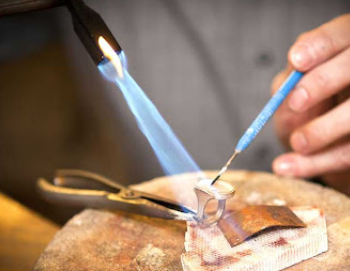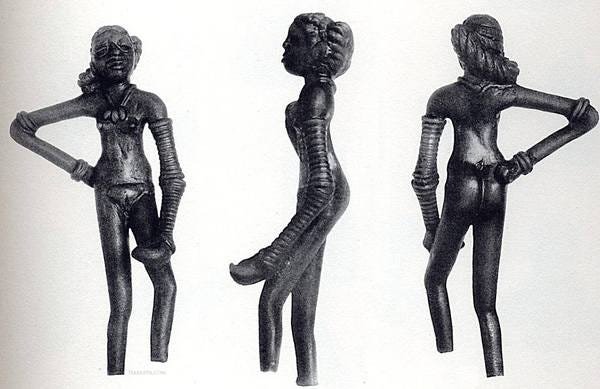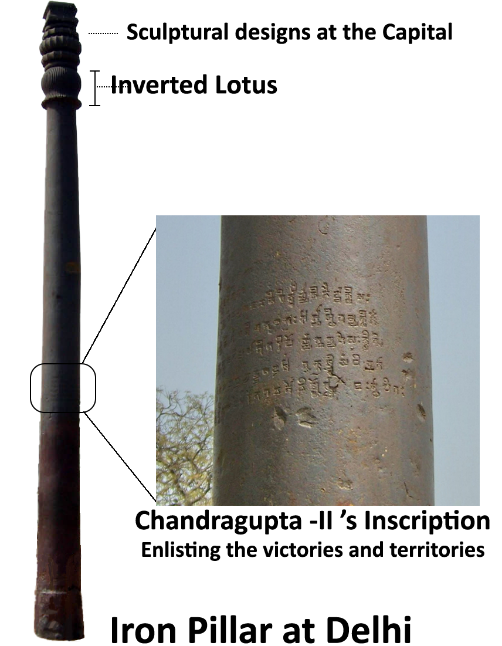Metal Sculptures
In this unit, we will try to understand the essential elements and how the metal sculptures were produced. With the techniques known to our people, they have produced incredible artistic bronze sculptures from very early times.
The art of metal casting always received great attention and is of the highest antiquity. The metal sculptures are found even in the Indus Valley period, around 3000 BC. Sculpture There are two basic techniques in metal casting –
Lost-wax method:
This technique is used for making metal objects, especially in Odisha, Bihar, Madhya Pradesh, West Bengal, and Himachal Pradesh. In each region, a slightly different technique is used.
Lost-wax casting is the process of a duplicate sculpture (often a metal, such as gold, silver, brass, or bronze) being cast from an original sculpture. By this technique, Intricate works can be achieved.
The oldest known example of the lost-wax technique to copper casting comes from a 6,000-year-old copper, wheel-shaped amulet found at Mehrgarh.

The steps to be followed in this method are:
- Wax Preparation: Pure wax (bee) is melted in an open fire and then sieved through a fine cloth into a basin of chilled water, where it solidifies immediately.
- Wax statue making: A wax model of the image is made. After that, it is pressed through a pichki or pharni, squeezing the wax into a noodle form. Now, these wax wires are wound around to the shape of the entire image.
- Shell Making: This image is now tunicated with a thick coating of paste made of an equal proportion of clay, sand, and cow dung.
- Dewaxing and Pouring: A clay pot is fixed into an opening on one side. In this, molten metal is poured gradually. The weight of the metal to be used is ten times that of wax. The model is simultaneously exposed to firing while the molten metal is engulfed in the clay pot. As the wax inside melts, the metal streams down the channel and takes the shape of the wax image.
- Shattering: Breaking of the clay mould.
- Finishing: The sculptors give the final touches by cutting unnecessary parts, carving the decorations, and polishing the image.
The sculpture of the dancing girl from the Indus Valley is the earliest example of metal sculpture in India. But the finest examples are the Nataraja sculptures from the Chola period.
Hollow-wax method:
The other method followed was to create a model in clay with all the details and then pour the liquid metal thinly all over the model. After cooling, the clay part is removed, and the mould would be hollow. Such sculptures come from many folk traditions.
| What is Bronze? |
| Bronze (Kansya) is an alloy comprised primarily of copper (Cu), commonly with about 12–12.5% tin (Sn). In contrast, Brass (pital) is an alloy of copper and Zinc. Pure copper is known as Tamba.These produce a range of alloys that may be harder than copper with strength, ductility, or machinability properties. |
Precious metal craft in India
Gold was oldest metal discovered anywhere in the world. Silver was discovered during the Bronze age around the world. Ever since, these craft have been created.
- Harappan times: We often find Gold and silver jewellery in hoards all around India right since the Harappan period. For example, earrings are very common amongst such finds. Sometimes beads were covered in Gold. It was rare and must have been used as a precious commodity.
- Vedic age: Several terms such as ‘Nishka’ (Coin) have been used in these times which show the use of gold.
- Indo-Greeks and Kushan Empires saw a huge import of gold into India due to India’s trade surplus and its connectivity with the Silk route.
Gold and Silver sculptures have been rare throughout the history, and the method of their production have been a bit different than that of Bronze sculptures. Often forging and welding is used to make gold sculptures.
Apart from these processes Punch marking and Minting are two more processes through which metal coins or sheets can be shaped. We’ve covered these topics in the chapter related to Coins and currency.
INDIAN BRONZE SCULPTURE
Indian sculptors had attained excellence in the bronze sculpture and casting process as much as they had mastered terracotta and stone sculpture. The cire-perdu or ‘lost-wax’ process for casting was learned in the Harappan Culture.
The Harappan people discovered the process of making an alloy of metals by mixing copper, zinc, and tin, called bronze.
Bronze sculptures and figurines of Buddhist, Jain, and Hindu icons dating from the 2nd century until the 16th century have been discovered in many regions of India. Most of these were used for ritual worship and are characterised by subtle beauty and aesthetic appeal.
Evolution of Bronze Sculpture
Bronze sculptures and figurines of Hindus, Buddhists, and Jains have been discovered in the Indian subcontinent from the second century until the sixteenth century. In the olden days, castings in India were often made in pure copper, but later, bronze became the preferred material for sculpture due to its high tensile strength.
Indus valley civilisation:
Harappan civilisation was the first urban culture in the Indian subcontinent. It was a bronze age culture that flourished in the North-western Indian subcontinent. Although various sites in the Indus Valley date back to the Neolithic era from before 5000 BCE, the ‘bronze age’ Harappan civilisation is dated between 3300 BCE to 1300 BCE.
The Harappan civilisation saw a wide-scale practice of bronze casting. The bronze statues were formed using the “lost wax technique”. Even now, the same technique is practised in many parts of the country.
Most prominent Examples from the Harappan civilization are the bronze dancing girl of Mohenjo-daro, the bronze bull of Kalibangan, etc.
In Birhana village, a dancing girl (a replica of “Dancing Girl” from Mohenjo-Daro) was engraved on a potsherd as graffiti was excavated.
Pre-Mauryan Art
Copper Hoard Culture 
In the 2nd Millennium BCE, we find hoards of copper associated with the Ochre coloured pottery culture in the Ganga-Yamuna Doab. This culture spread from Northern Haryana and Rajasthan till Madhya Pradesh in the south and covering the Doab region till the Chhotanagpur plateau. We have covered this period in the Chalcolithic age chapter of Ancient India.
We find arrow head, spear heads, Anthropomorphic (human-like) figures of copper in hoards.
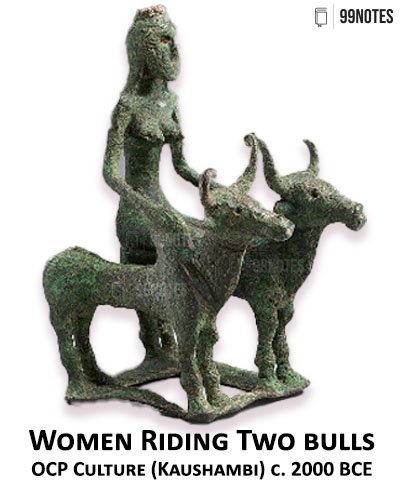 Apart from Copper artefacts, we also find Bronze sculptures. For example, a Woman riding two bulls is a major find from Kaushambi.
Apart from Copper artefacts, we also find Bronze sculptures. For example, a Woman riding two bulls is a major find from Kaushambi.
Jowre Culture (1400-700BCE)
A group of bronze statues similar to that of the Harappan culture has been discovered from archaeological excavations at Daimabad (Maharashtra, 1500 BCE).
- Significant is the ‘Chariot‘; the wheels are represented in circular shapes while the driver has been elongated, and the bulls in the forefront are modelled in sturdy forms.

- This signifies that people must have good geometrical knowledge, and they used to make geometrical shapes with lost wax techniques as such intricate shapes are impossible to make without any special techniques.
Iron Age
In the Vedic age, Metallurgy was known, and the term ‘Ayas‘ (metal) was used to refer to Copper or Bronze. In the later Vedic age, ‘Syam Ayas‘ (black metal) was referred to as Iron. The period after 1000BCE is marked by the widespread use of Iron in India. Copper was also found at various Later Vedic (PGW) sites, one of the first metals to be used by Vedic people.
There are various hotly debated older discoveries of Iron from other areas of India too. By any account, India’s Iron craft is one of the oldest in the world. However, rarely these piecies of Iron have survive as it oxidises rapidly, forming rust. It is then amazing that the Iron Pillar of Mehrauli survived for more than 1600 years.
Evolution of modern Bronze Craft in India
Post Mauryan Period:

Images of Jain Tirthankaras, specifically Adinatha or Vrishabhnath Naminath, have been excavated from Chausa, modern Bihar, belonging to the Kushanas (2nd century CE).
- These bronze sculptures show how the Indian sculptors had mastered modelling the masculine human physique and simplified muscles.
- The style is similar to the stone sculptures produced in the Gandhara as well as the Mathura styles.
Gupta and post-Gupta periods
The typically refined style of bronze sculpture is the hallmark of the classical quality of this era. Many standing Buddha statues with a right hand in abhaya mudra were excavated in North India, especially in Uttar Pradesh and Bihar, during the Gupta and Post-Gupta periods (5th-7th centuries).

- Portable images: small images were produced in large numbers which monks carried from place to place for personal worship or to be installed in various Buddhist viharas. In this way, this style spread over the different parts of India and other countries.
- Drapery Style: In the Gupta and Post-Gupta age, the idols were covered with Sanghati (monk’s robe) and grappled to cover the shoulders, which turned over the right arm, which is in Abhaya Mudra. At the same time, the other end of the drapery is wrapped upon the left arm, pleats are held by the extended hand of the same arm, and the drapery falls and spreads into a wide curve at the ankle level. For example,
- Drapary in Mathura Style in Khera.
- Sarnath-style bronzes have foldless drapery.
- At the same time, a significant change in the draping style of the monk’s robe was noticed.
- Introduction of Throne: A new format was introduced in which Tirthankaras are inhabited on a throne; they can be single or combined in a group of 3 or 24 Tirthankaras.
- Amaravati Style: In Vakataka, bronze images (Phophnar, Maharashtra), the influence of the Amravati Style was prominent. Vakataka bronze idol of the Buddha from Phophnar (Maharashtra) is contemporary with the Gupta period bronze sculptures. They also exhibit the influence of the Amaravati style of Andhra Pradesh.
Other Idols Produced in Post Gupta-age: 
- Female idols were also produced representing yakshinis or Shasanadevis of some prominent Tirthankaras, highly influenced by the features of the Guptas and Vakatakas.
- The discovery of a hoard of bronzes in Akota (Vadodara) established that bronze casting was practised in Gujarat (western India) between the 6th and 9th
Regional Sculptures
Kashmir and Himachal Pradesh:
- Kashmir and HP yielded bronze images of Buddhist deities, Hindu gods, and goddesses. The Mahishasuramardini Durga images and Narasimha avatar of Himachal Pradesh are among that region’s very dynamic bronze sculptures.
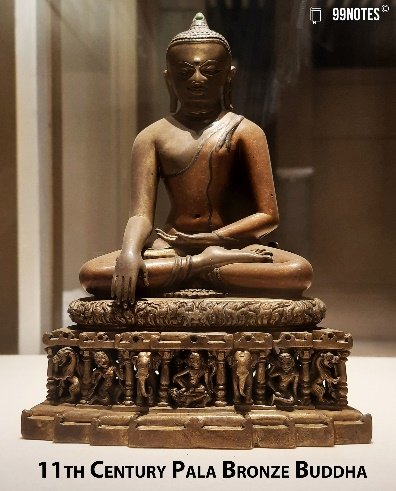
- Most of them were created during the 8th, 9th, and 10th centuries and have a distinct style compared to bronzes from other parts of India.
- A significant development is the growth of different types of iconographies of Vishnu
- For example, Chaturanana (4-headed – Vaikuntha Vishnu) was worshipped. While the central face represents Vasudeva, the other two are Narasimha‘s and Varaha‘s.
Pala and Sena dynasty:
- Large-sized bronze sculptures of the Pala and later Sena dynasty of the 8th century are significant for execution and finish. For example, Mahishasuramardini Durga.
- Nalanda school of bronze-casting emerged around the 9th century during the rule of the Palas in Bihar and Bengal.
- After a few centuries, the sculptors at Kurkihar (Nalanda) could revive the classical style of the Gupta period.
- An example is the Four-armed Avalokitesvara (a male figure in a graceful tribhanga posture).
- Female goddesses Tara (Vajrayana Buddhism).
Pallava Age
In Southern India, during the Pallava age, a bronze sculpture of Shiva in Ardhaparyanka asana (one leg kept dangling), Right hand in Achamana mudra, suggesting that he is about to drink poison, is discovered. 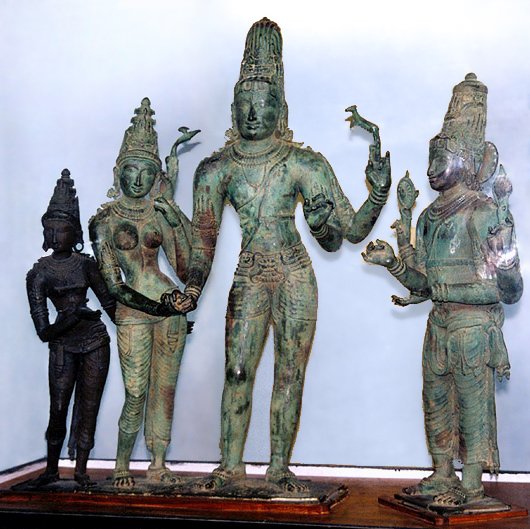
Chola Age
- Although bronze casting has a long history in India, mastery of this technique scaled new heights of excellence during the rule of the Chola dynasty (850 CE — 1250 CE).
- Sembiyan Maha Devi, a widowed Chola Queen, was a great patron of bronze works.
- In the Chola period, bronze sculptures of religious Hindu deities were created as movable alternatives to the immovable stone sculptures in the inner sanctum, as they could be carried outside the temple for daily rituals, processions, and temple festivals.
- The Chola bronzes were made using the lost wax technique called ‘Cire Perdue.’ This is still practised in
- Nataraja is one of the most common subjects depicted in Chola bronzes.
- Kalyana Sundara murti of the 9th century is another prominent example of a Chola bronze sculpture. In this sculpture, Panigrahana (ceremony of marriage) is represented.
Chola Bronze Sculptures: 
The Chola bronze images are famed across the world for their excellence. Bronze images were of deities and, at times, were made of devotees. An important piece of Chola sculpture was the sculpture of Nataraja in the Tandava dance posture.
The most prominent Chola bronze sculpture is of Shiva. Shiva was represented in two forms: Lingodbhava and Human form.
- Lingodhbhava Form represents Shiva emerging out of the Shiva Linga.
- Human form as: Nataraja (cosmic dancer form) or Ardhanariswara (half women form), or various other forms
These sculptural styles are covered in the chapter related to the Stone sculptures.
| NATARAJA |
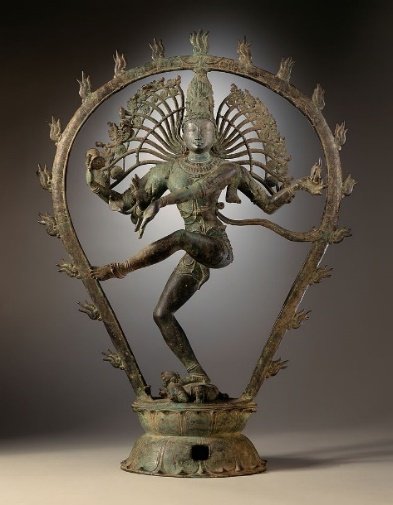 Nataraja is a significant Hindu deity, symbolising lord Shiva in his cosmic dance form. The earliest known Nataraja sculpture has been excavated at Ravana Phadi cave (Aihole) and was made during the early Chalukya’s reign; the sculpture reached its peak under the Cholas.
|
Vijayanagar Period:
At Tirupati, life-size standing statues were cast in bronze, depicting the king Krishnadevaraya with his 2 queens, Tirumalamba and Chinnadevi, depicted in praying posture, i.e., both hands held in the namaskar mudra.
The likeness of the facial features combined with certain elements of idealisation. The body is modelled to appear imposing as well as graceful.
Local Metal Crafts in India
Bidri Craft
Bidri is a metal handicraft from the city of Bidar in Norther Karnataka. It developed around the 14th century during the Bahmani Sultanates.
This technique is influenced by Persian art. It is said to have been brought by Sufi saint Khwaja Moinuddin Hasan Chisti in the form of utensils to India.
It uses blackened white brass, inlaid with silver, to produce its characteristic design.
Process of making Bidriware: 
Step 1: Casting – Molten White Brass is first poured into cast piece and then filed upon solidification.
Step 2: Blackening – The casting is coated with a strong solution of Copper Sulphate to obtain a temporary black coating.
Step 3: Inlay work: Then with the help of small chisel designs are etched freehand and then a fine wire or flattened strips of pure silver are carefully hammered into the grooves.
Recognition: In 2006, the government of India granted a GI Status to Bidriware.
| The Vishvakarma Community |
| In the Medieval times, all major sculptural crafts were enlisted as the Panchalas or Vishwakarma community. These were goldsmith, bronzesmiths, blacksmiths, masons and Carpenters. These were the builders of our society. According to mythological claims they are the descendants of Vishvakarma, the builder and architect of heavenly realm.The people from these communities lived close to the temple and often dependent on the temple economy. They enjoyed great amount of privilege in the society. However, by the end of the Medieval period such prestige eroded probably due to the decline of the artisan economy. |
Conclusion
Each Indian sculpture made using the lost wax technique is unique in its own way. And the beauty of lost wax sculptures lies as much in their detailing as it does in the fact that they are truly one-of-a-kind.
archaeologists and historians in comprehending our history in an inclusive manner.




